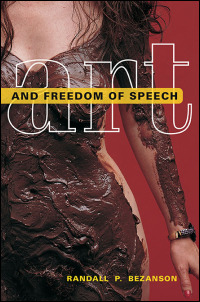 Randall P Bezanson has just pubished another very important book on on Art and Freedom of Speech (University of Illinois Press, 2009), exploring the decisions of the US Supreme Court relating to artistic expression under the First Amendment. From the abstract:
Randall P Bezanson has just pubished another very important book on on Art and Freedom of Speech (University of Illinois Press, 2009), exploring the decisions of the US Supreme Court relating to artistic expression under the First Amendment. From the abstract:
… In considering the transformative meaning of art, the importance of community judgments, and the definition of speech in Court rulings, Bezanson focuses on the fundamental questions underlying the discussion of art as protected free speech: What are the boundaries of art? What are the limits on the government’s role as supporter and “patron” of the arts? And what role, if any, may core social values of decency, respect, and equality play in limiting the production or distribution of art?
Accessibly written and evocatively argued, Art and Freedom of Speech explores these questions and concludes with the argument that, for legal purposes, art should be absolutely free under the First Amendment–in fact, even more free than other forms of speech.
In matters that have recently featured on this blog, his views on blasphemy (discussed here) and treaspassory art (discussed here) will resonate with our recent blasphemy and Cowengate controversies.
Mark Tushnet has written an excellent discussion of Bezanson’s book. Posing the question “Why exactly are Jackson Pollock’s paintings protected by the First Amendment?”, he argues that
People should check their wallets whenever the Supreme Court takes some proposition as unquestionable. Randall Bezanson shows why. Every route that you might take to explain why non-representational art is covered by the First Amendment leads to mind-bending problems, and rather rapidly places some other unquestionable proposition about free speech under pretty severe pressure. …
This isn’t to say that Bezanson’s proposed solution to the problems posed for the First Amendment by non-representational art is satisfactory. He says that art should be absolutely protected against government sanction, even more so than propositional speech. … Bezanson sometimes seems to think that his absolute rule is tolerable because he would apply it only to serious art. … Early on, Andy Warhol’s work wasn’t “serious” enough. Now it’s central to the study of mid-twentieth century art, full stop. Rules that purport to make important differences turn on a distinction between serious art and unserious “art” are unlikely to succeed.
It’s worth reading Tushnet’s review in full, and then it’s worth reading Bezanson’s book too. It demonstrates that the most profound questions about freedom of expression are often raised not in the context of the participatory political process but in the contested field of human emotions. The problems outlined in the book are universal; the analysis may be centred on the First Amendment; but it will surely provide a sure guide if and when the issues come up in other courts on foot of other free speech guarantees.
While one is wary of taking on an eminent professor speaking within his area of expertise, Professor Tushnet’s criticisms are way off the mark.
First, it is simply incorrect to assert, as Professor Tushnet does, that a ‘socially constructed’ meaning of speech leads to ‘madness’ or is inconsistent with the approach taken to the First Amendment by the Courts. The US Supreme Court, in its cross burning jurisprudence, had great regard to the particular socially constructed meanings attached to cross burning in the US (see Virginia v. Black, particularly Justice Thomas’ moving dissent). Indeed, much non-representational art (such as flags, logos and images) can communicate political ideas. The art communicates such ideas because of its socially constructed meaning.
Second, contrary to Professor Tushnet’s implication that it is difficult to afford a coherent theoretical justification for the protection of non-representational art, I would suggest that such speech can, without much difficulty, be brought within the traditional rationales for free speech protection:
Political speech is often at its most powerful when it relies upon rich imagery. The protection of such political speech should not be predicated on the evaluation by a judge as to whether or not the images used are ‘representational’ or ‘non-representational’. Indeed, the very images by which a political movement defines itself may be ‘non-representational’ – should such images be left unprotected?
Moreover, if we see the First Amendment as protecting the equality or autonomy of speakers, then there is no logical ground for a distinction between representational and non-representational art. The mere fact that an visual expression does not ‘look like something’ does not alter the fact that repressing that expression limits the communication rights of the non-representational artist and sends a clear message that he or she is not a full member of the political community.